MG ZS Hybrid+ 2024 review: Bigger and better, but still a bargain?
No electric power this time around
Once upon a time, the MG brand was all about exciting sports cars, and it came with a certain air of sophistication. George Best, Steve McQueen and even His Majesty the King (then the Prince of Wales) all had MGs, and the cars weren’t just driven by stars; they were stars in their own right. Bond aficionados may remember Britt Ekland driving an MGB in The Man with the Golden Gun, and who can forget Christopher Plummer’s little MG PA in The Battle of Britain?
These days, though, things are a little different, and despite the efforts of the futuristic new Cyberster, the MG brand is more likely to excite your bank manager than any fighter pilot. This is a brand that these days stands for value above all else.
But even among MG’s modern flock of great-value offerings, few stand out as much as the ZS. A compact SUV intended to compete with the likes of the Peugeot 2008 and Skoda Kamiq, it has long been praised for giving you lots of car in exchange for not a lot of money, and it has sold accordingly. In the UK alone, more than 100,000 examples have been delivered since the ZS’s introduction in 2017, and MG is hoping to grow that number further still with this latest version.
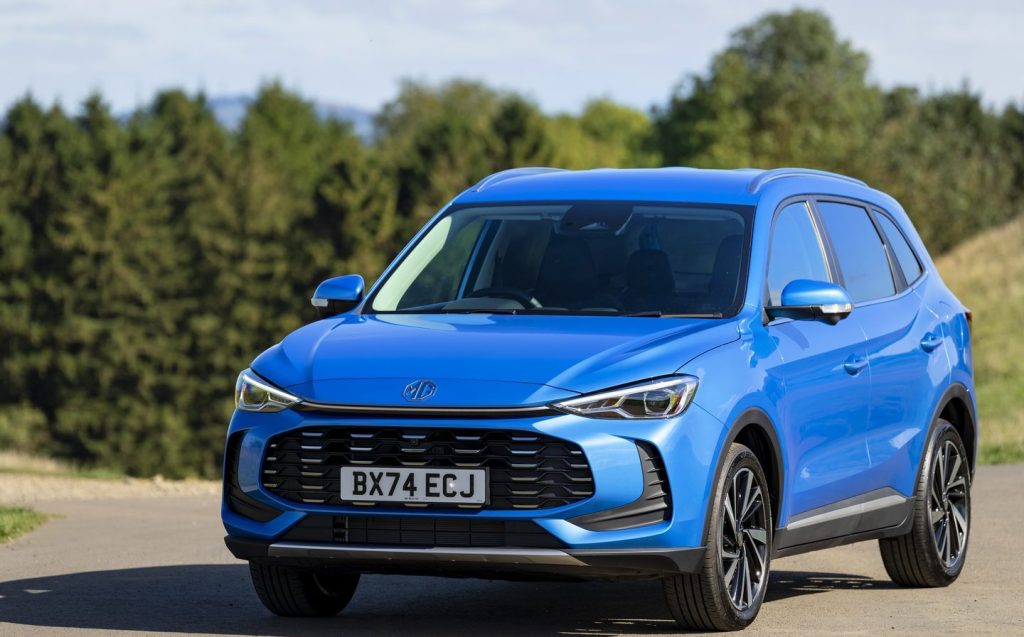
And this isn’t just a mildly updated car with a big new grille, as MG has made wholesale changes inside and under the skin, and the company reckons its new model will prove more efficient, more upmarket and more high-tech than the old ZS, without being significantly more expensive. Starting at £21,995, it’s £1,105 more than the equivalent outgoing MG ZS. Perhaps more pertinently, though, this new model is more than three grand dearer than the entry-level Dacia Duster, which is the clear value leader among rivals, while a VW T-Roc is significantly dearer, starting at £28,430.
Its price bump over the old ZS is also reflected in the fact that it has grown considerably. It’s about 10cm longer than its predecessor, and a little taller and wider, which means there’s much more room inside. Rear headroom and legroom are remarkably generous, in fact, and tall passengers will be more than comfortable. Certainly, it makes the space in the back of a T-Roc, which is hardly an impractical thing, look a bit ordinary.
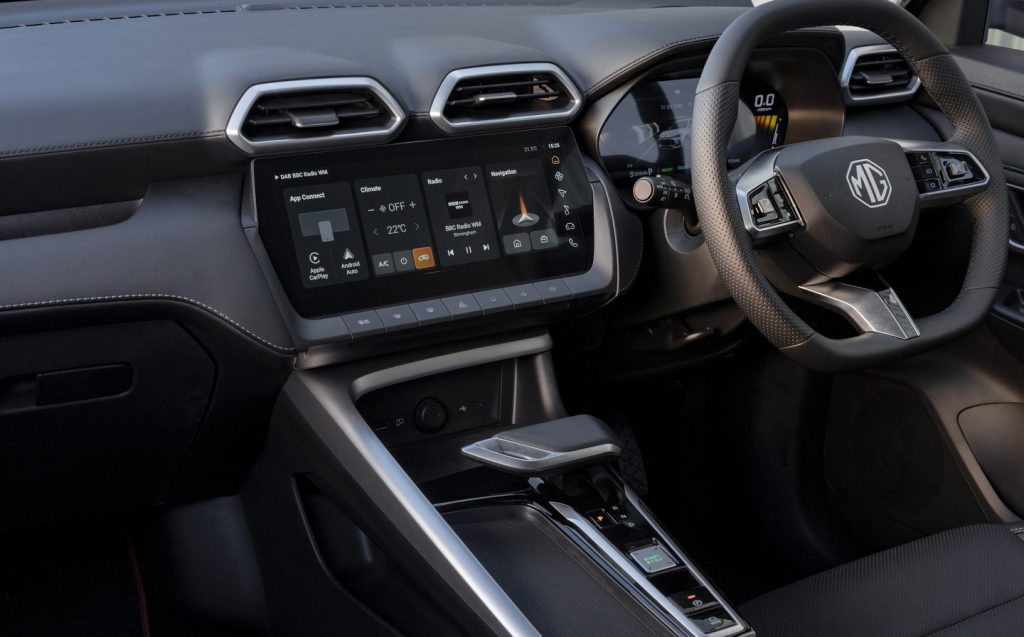
The two cars are very evenly matched in terms of boot space, but more surprising is that the MG has a remarkably competitive interior. The company has upgraded the ZS’s cabin dramatically, fitting it out with a new touchscreen and a digital instrument cluster, while there are lots of relatively tactile materials kicking about despite the price tag.
Of course, there’s some evidence that this is not a premium product — the touchscreen is laggy, the steering wheel controls are unfathomable and the bank of buttons on the dash feels a bit cheap — but none of those issues is a deal breaker.
This is especially true when you get so much standard equipment. Even basic SE models include a reversing camera, navigation and automatic climate control, not to mention keyless entry, parking sensors and automatic lights and wipers. Our range-topping Trophy test car came with leather upholstery, heated front seats and a heated steering wheel, not to mention an upgraded, 360-degree camera system and 18in alloys, all for less than £25,000 — still significantly less than a more basic T-Roc. Mind you, the top spec Duster Extreme is still cheaper, at £23,745.
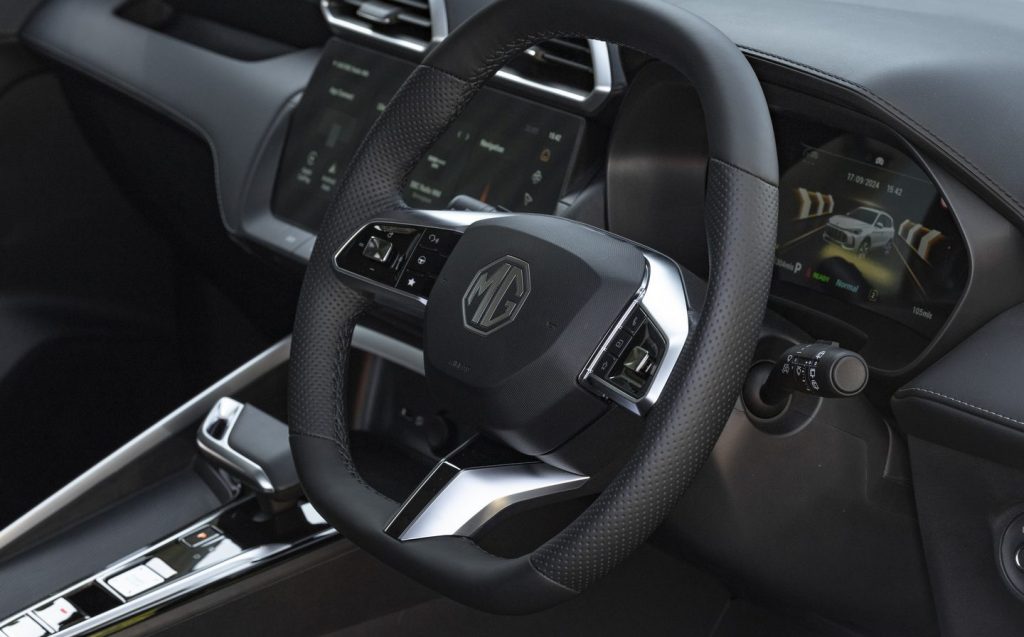
Perhaps the most critical piece of the ZS’s equipment is found under the bonnet, where MG has fitted the hybrid system from the smaller MG3 hatchback. It’s true that putting the engine from a supermini in a family SUV may sound like the automotive equivalent of fitting an airliner with a microlight propeller, but bear with us on this one because the system works much better than you might expect.
In essence, the ZS gets an unremarkable 1.5-litre, four-cylinder petrol engine, which is then combined with a 136kW electric motor, housed within the automatic gearbox. And although the concept of a three-speed automatic gearbox feels a little 1980s, it’s capable of transmitting an ample 194bhp from the MG’s powertrain to its front wheels. That’s quite a lot — noticeably more than you’ll get from the Dacia and most T-Rocs — and the MG doesn’t struggle for grunt.
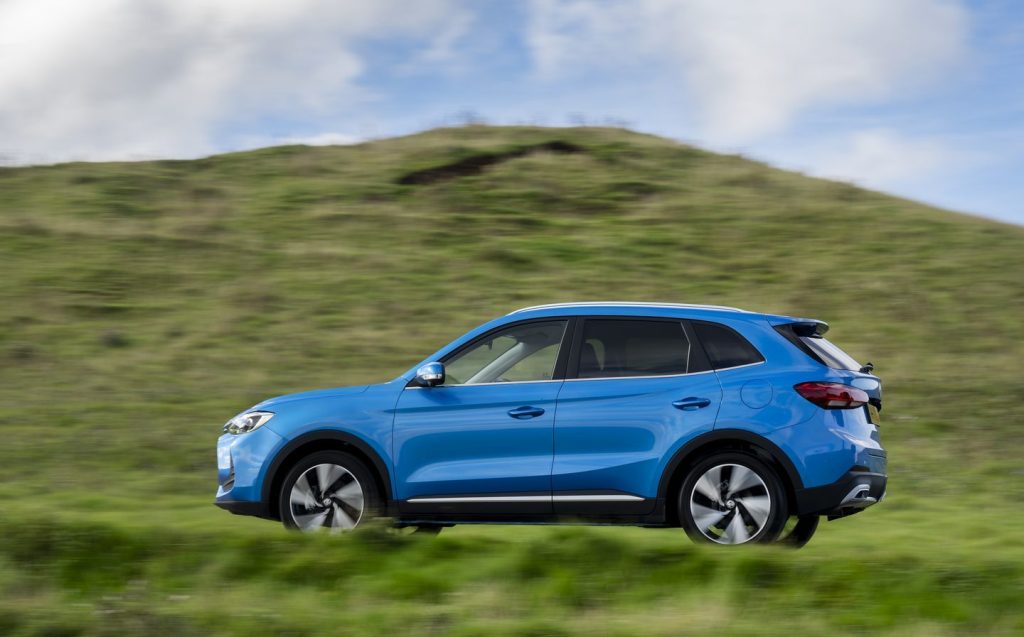
We suspect the respectable but unremarkable official 0-62mph time of 8.7 seconds would be improved by a slightly more 21st century gearbox, but the ZS has more than enough poke to keep up with traffic. It’s even fairly competent when it comes to overtaking on a country road, and it’s largely quite smooth. The electric motor powers the wheels much of the time, and nine times out of ten, you barely notice the engine joining in when required.
Just occasionally, though, the gearbox computers will make some odd decisions that leave the engine moaning away in the background like some kind of frustrated troll. It does a similar thing when you put your foot down, too.
In truth, though, few customers are likely to put their foot down too often in the ZS, and the “Hybrid+” system, as it is called, will be perfectly competent most of the time.
It’s certainly efficient. On our test, which included some driving we shall euphemistically describe as “spirited”, it returned almost 50mpg, and the official figures suggest it’ll do 55mpg if you’re careful. Either way, it isn’t bad for an SUV with almost 200bhp.
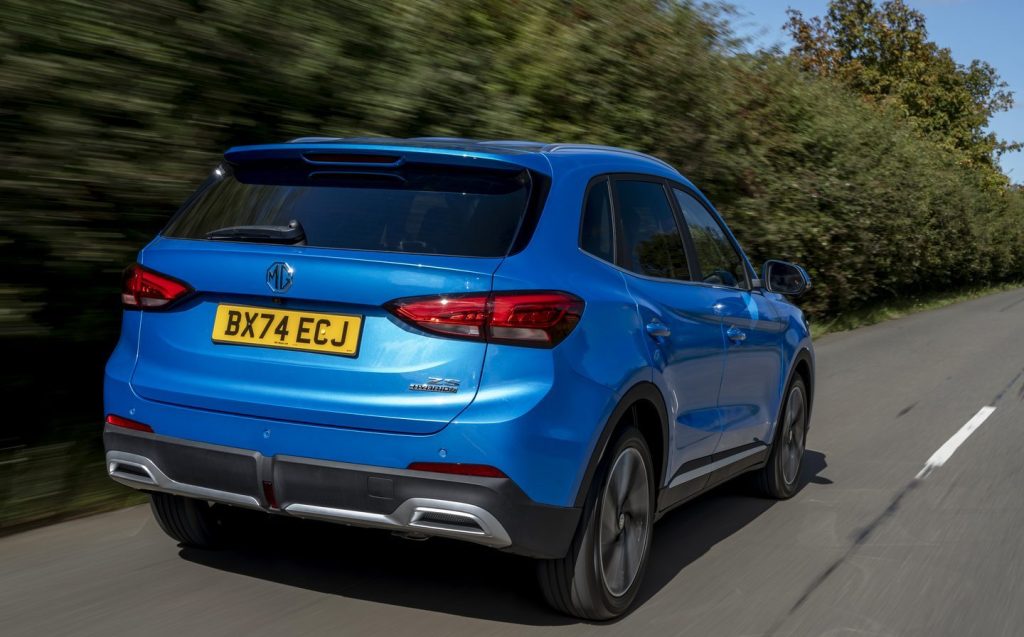
Some might be surprised to hear, however, that the Hybrid+ is likely to be the most efficient ZS model we see. The old ZS is offered in petrol and electric forms, but the new model will only get this hybrid system and a cheaper, purely petrol-powered alternative. The existing ZS EV will be replaced with a standalone model, rather than a derivative of an existing product.
It isn’t all bad news for future ZS models, though, because MG is blaming the introduction of hybrid technology for a little shrinking of the new model’s boot capacity relative to that of the outgoing ZS. As a result, the 443-litre space offered in the new car (down from 448 litres in the old ZS) will likely grow slightly when the petrol model is introduced. And the petrol option is likely to be even cheaper than the Hybrid+, but it will come with much the same level of standard equipment.
Whether the petrol is any better to drive, however, remains to be seen, because the hybrid is no great shakes on the road. Around town, the powertrain is perfectly competent and light steering makes it relatively easy to manoeuvre, while the suspension does a decent job of dealing with speed bumps and the like. It feels a little less composed over sharper bumps such as potholes. But even then, the ride is just about acceptable, and it improves on the motorway.
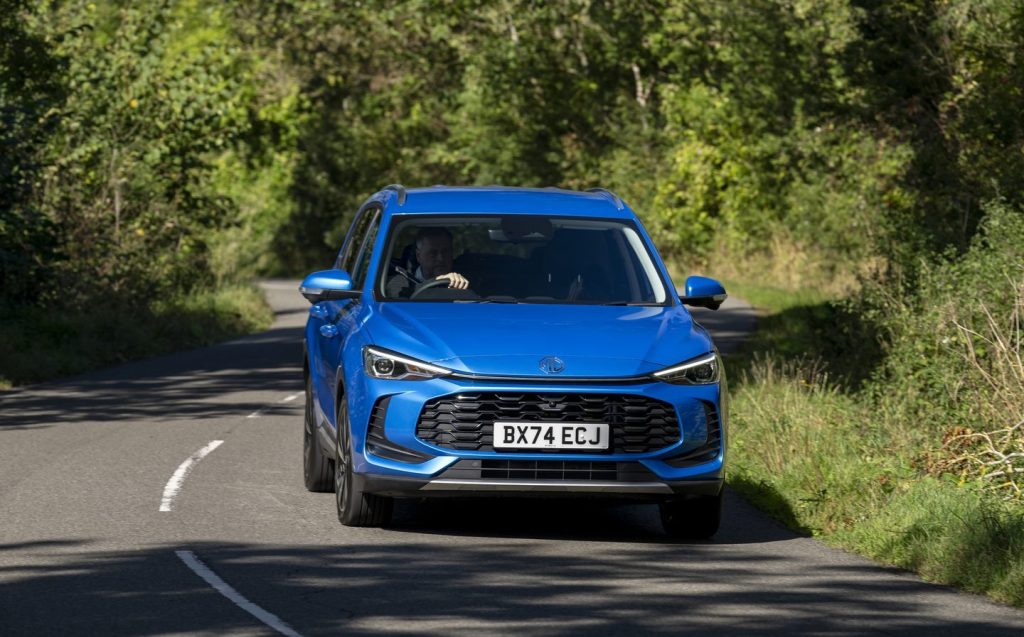
And though the ride may improve as speed builds, the refinement does not. While the powertrain is only noisy in certain situations, the road noise from the MG’s tyres is quite loud over almost any surface on the motorway network, and that reduces the comfort significantly on long journeys.
The other disappointment is the way the car handles, which is not going to ring any alarm bells among established European brands. The brakes are reassuringly heavy and they’re quite consistent, but the light steering is almost entirely devoid of feel, and though the car doesn’t lean all that much in corners, what movement there is doesn’t feel especially well controlled. Challenge the car with a sub-optimal road surface (they’re plentiful enough) and a corner entry speed that’s higher than “relaxed” and you’ll find it wanting, especially compared with the likes of the Mazda CX-30 and the Peugeot 2008.
But while the handling may not be great, and the tech may not be brilliant, they are really the only shortcomings in what is otherwise a wholly competent package. SUVs of this size are really about space, efficiency and equipment, all of which the ZS has in abundance. Add a surprisingly pleasant cabin to the mix and you’ve got a car that’s flawed, but fundamentally sound. And when it costs less than £25,000 even in top-of-the-range form, it’s almost certain to be a success.
Chinese car makers
MG is a British brand owned by SAIC Motor, one of China’s “Big Four” state-owned vehicle manufacturers.
Related articles
- If you found this review of the new MG ZS Hybrid+ interesting, you might like to read about the most reliable cars list still being dominated by Japanese and Korean car makers
- You may also want to read our review of the MG4 electric hatch
- Interested in safety? The UK regulator has told carmakers to reduce the reliance on touchscreens or face lower ratings
Latest articles
- Lewis Hamilton wants to design a modern day Ferrari F40 with manual gearbox
- Dacia Bigster 2025 review: The ‘anti-premium’ family SUV that punches above its weight
- Your car’s worn tyres could be being burnt illegally in India, investigation reveals
- Open-top 214mph Aston Martin Vanquish Volante is world’s fastest blow-dry
- F1 2025 calendar and race reports: The new Formula One season as it happens
- Alfa Romeo Junior Ibrida 2025 review: Hybrid power adds an extra string to crossover’s bow
- Top 10 longest-range electric cars: all with over 400 miles per charge (officially)
- Renault 5 Turbo 3E ‘mini supercar’ confirmed with rear in-wheel motors producing 533bhp … and insane levels of torque
- British firm Longbow reveals ‘featherweight’ electric sports cars with 275-mile range














